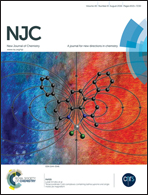The synthesis and highly sensitive detection of water content in THF using a novel solvatochromic AIE polymer containing diketopyrrolopyrrole and triphenylamine†
Abstract
A novel electron donor–acceptor polymer (N1) containing diketopyrrolopyrrole as an electron acceptor and triphenylamine as an electron donor has been designed and synthesized. N1 is shown to possess the remarkable dual properties of solvatochromism and aggregation-induced emission (AIE). Importantly, N1 is found to serve as a fluorescence indicator for the qualitative and quantitative detection of low-level water in THF. Moreover, the quaternization of N1 by CH3I gave ammonium-salt P1. A selective fluorescence turn-on probe for bovine serum albumin (BSA) detection and quantification is developed by taking advantage of the aggregating process of P1. It is found that the intrinsic weak fluorescence of P1 in DMSO/PBS (1 : 1, v/v) increases to 2.9-fold after the addition of 50 μM BSA through electrostatic complexation and hydrophobic interaction.


 Please wait while we load your content...
Please wait while we load your content...